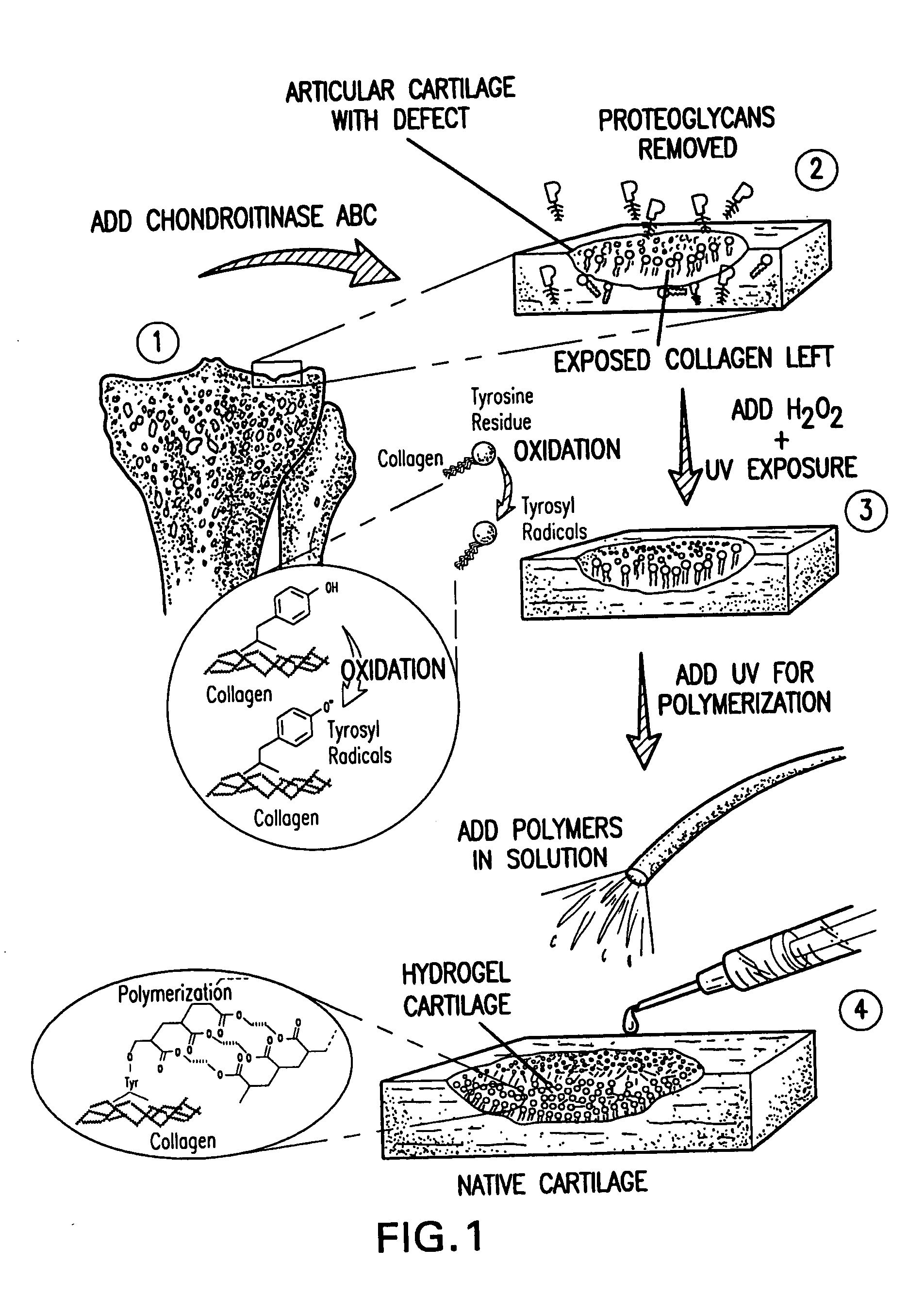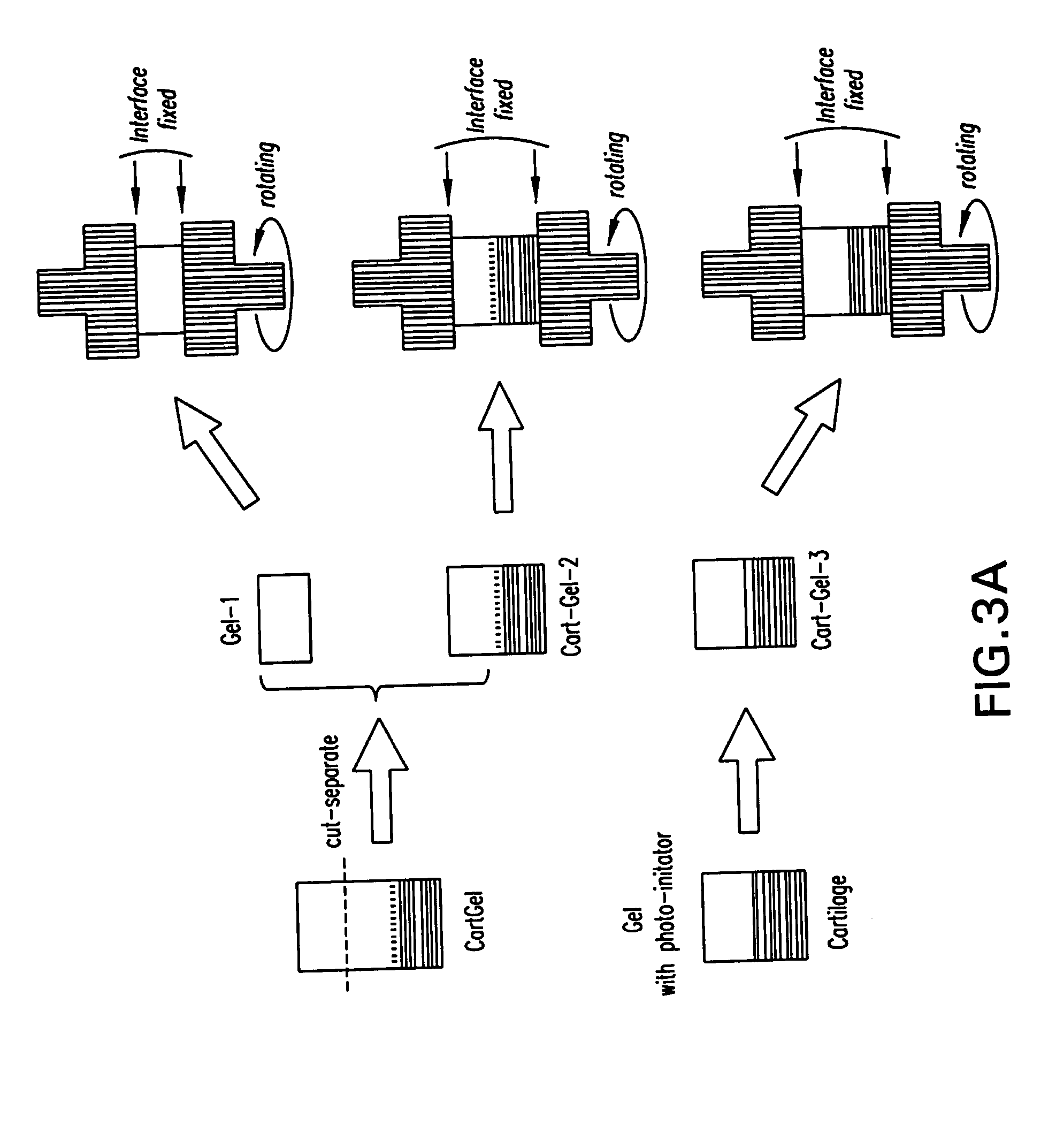Method and material for enhanced tissue-biomaterial integration
a biomaterial and tissue technology, applied in the direction of skeletal/connective tissue cells, drug compositions, prostheses, etc., can solve the problems of biomaterial lack of proper integration with the body, and sacrifice of implant longevity and function,
- Summary
- Abstract
- Description
- Claims
- Application Information
AI Technical Summary
Benefits of technology
Problems solved by technology
Method used
Image
Examples
example i
[0121] An exemplary in vitro protocol is discussed below. Surfaces of fresh fetal bovine cartilage chips were treated with chondroitinase ABC (5 unit / ml, in Tris pH 8.1) at 37° C. for 1 hr. Photo-oxidation of these surfaces was performed for 5 min with H2O2 (5%) and UV-irradiation (365 nm; 3 mW / cm2). Excess H2O2 was removed. Pre-argon-bubbled PEODM (poly[ethylene glycol] dimethacrylate, 15% and 20%, w / v) were added to the cartilage surfaces without photo-initiators. The reactants underwent the UV-irradiation (365 nm; 8 mW / cm2) for 30 min.
[0122] Chemical and morphological analysis was performed on the cartilage-biomaterial construct to confirm tissue-initiated polymerization and gel formation (FIG. 2). The superficial layer of native cartilage is a mixture of proteins, proteoglycans, and bonded water as seen chemically by Fourier transform infrared spectroscopy (ATR-FTIR) spectrum d. After enzymatic treatment of the cartilage surface with chondroitinase ABC, the poly(saccharide) pea...
example ii
[0126] Analysis of the mechanism of the tissue-initiated polymerization and direct covalent integration according to the present invention was carried out in a simplified system using pure collagen protein and hydroxyethyl methacrylate (HEMA). Collagen was chosen as the target for reaction due to its universal presence and mechanical stability. Collagen contains tyrosine residues which may be oxidized to produce the initiating radical for polymerization. While tyrosine makes up only 0.6% of human Type II collagen, 90% of these residues are located at the protein C-terminus, providing a concentrated source of radicals for polymerization.
[0127] Type II collagen was reacted with H2O2 (1%) for 15 min. After the un-reacted H2O2 was removed, HEMA (250 mM) was added and the UV-irradiation (365 nm; 3 mW / cm2) was performed for 5 min. The product solution was loaded into the Sephadex® (Amersham) G-25 size exclusion column to remove the excess HEMA monomer and the potential byproduct of oligo...
example iii
[0135]FIG. 7 illustrates the aldehyde priming embodiment of the invention. The method described below may be found in more detail in Li et al., Macromolecules vol.36, pp. 2556-2562 (2003), the entire disclosure of which is hereby incorporated by reference.
[0136] Chondroitin sulfate A sodium salt (CS, 10 g, ˜20 mmol disaccharide repeating unit) was dissolved in 100 ml phosphate buffer saline (PBS, pH 7.4), followed by addition of glycidyl methacrylate (GMA, 3 g, ˜20 mmol) while vigorously stirring at room temperature for 1 to 15 days. The purification was performed by anhydrous acetone extraction twice to remove all the compounds that failed to covalently graft onto CS chains. The purified products were lyophilized for 48 hrs. The final yield of chondroitin sulfate methacrylate (CS-MA) product was all 7 to 8 g.
[0137] Six hundred mg of CS-MA (0.8˜1.2 mmol of adjacent diol, 70% CS-A, Sigma) and 616 mg of sodium periodate (˜2.88 mmol, NaIO4, Sigma) were dissolved together in 10 ml of ...
PUM
| Property | Measurement | Unit |
|---|---|---|
| volume % | aaaaa | aaaaa |
| molecular weight | aaaaa | aaaaa |
| pH | aaaaa | aaaaa |
Abstract
Description
Claims
Application Information
 Login to View More
Login to View More - R&D
- Intellectual Property
- Life Sciences
- Materials
- Tech Scout
- Unparalleled Data Quality
- Higher Quality Content
- 60% Fewer Hallucinations
Browse by: Latest US Patents, China's latest patents, Technical Efficacy Thesaurus, Application Domain, Technology Topic, Popular Technical Reports.
© 2025 PatSnap. All rights reserved.Legal|Privacy policy|Modern Slavery Act Transparency Statement|Sitemap|About US| Contact US: help@patsnap.com



